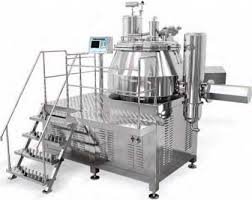Working Dynamics and Design Principle of a Rapid Mixer Granulator

Working and Principle of Rapid Mixer Granulator (RMG) – Detailed Explanation
A Rapid Mixer Granulator (RMG) is a high-performance industrial equipment widely used in the pharmaceutical industry for mixing and granulation of powders to form granules. This process is crucial in tablet manufacturing, as granules improve the flow properties and compressibility of powder blends.
1. Principle of RMG
The working principle of the Rapid Mixer Granulator is based on mechanical agitation by impeller and chopper blades, which promote intense mixing and wet granulation of powders using a granulating fluid.
The process relies on:
-
High shear mixing: A main impeller rotates at high speed, lifting and shearing the powder particles.
-
Granulation fluid addition: A binder solution or water is sprayed into the moving powder mass to initiate agglomeration.
-
Chopper action: A chopper blade rotates at high speed to break down large lumps and control granule size.
-
The result is a batch of uniform, dense, and free-flowing granules ready for drying and further processing.
2. Construction of RMG
An RMG typically consists of:
-
Mixing Bowl: Stainless steel bowl where powders are loaded and mixed.
-
Impeller: Bottom-mounted blade responsible for mixing and densifying the powder.
-
Chopper: Side-mounted blade that breaks down lumps and regulates granule size.
-
Discharge Port: Bottom outlet for transferring wet granules to the next stage (typically a fluid bed dryer).
-
Granulating Fluid Spray System: Used to uniformly distribute binder or granulating fluid.
-
Control Panel: Automates and controls the mixing and granulation process.
3. Working of RMG – Step-by-Step
Step 1: Loading
-
Dry powders (active ingredients and excipients) are loaded into the mixing bowl manually or via vacuum transfer.
Step 2: Dry Mixing
-
The impeller starts rotating to mix the dry ingredients uniformly (typically for 5–10 minutes depending on the material).
Step 3: Addition of Granulation Fluid
-
A binder solution (like starch paste, PVP solution, or purified water) is added via a spray nozzle or manually.
Step 4: Wet Mixing/Granulation
-
The impeller continues to mix the material while the chopper cuts and breaks agglomerates to form uniform granules.
Step 5: End-Point Determination
-
Granulation continues until the desired granule size and consistency are achieved. This is determined by time, torque, or in some systems, granule moisture content.
Step 6: Discharge
-
The granules are discharged through the bottom outlet into trays or directly into a fluid bed dryer for drying.
4. Advantages of RMG
-
Fast and uniform mixing and granulation.
-
Produces dense and free-flowing granules suitable for compression.
-
Reduced processing time compared to conventional granulation.
-
Easy to clean and maintain (especially with CIP systems).
-
Scalable from lab to production.
5. Applications of RMG
-
Pharmaceutical industry (tablet and capsule manufacturing).
-
Nutraceuticals and dietary supplements.
-
Chemical and food industries (for forming granules with uniform density and flow).
🎓 Discover one of the best Pharmaceutical Production courses available — click below to explore the course that’s shaping future Production skills.

